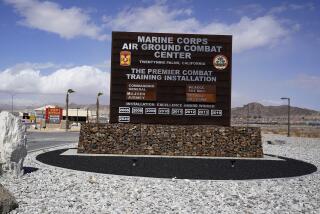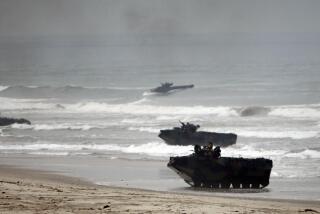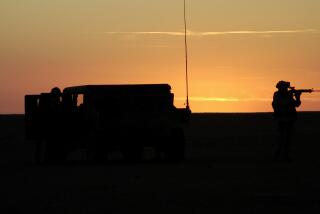What cops and hunters can teach Marines
- Share via
Camp Lejeune, N.C. — The enemy hides among civilians on the urban battlefield, walking the same dusty streets and in the same crowded markets where Cpl. Derrick Terrell found himself during a yearlong deployment in Iraq.
The Marine rifleman said he knew little about his surroundings -- an environment where basic infantry skills of shooting straight and heading out onto patrol were no longer enough.
It’s a potential weakness that led Terrell and hundreds of other Marines to spend time with big-game hunters and police, learning to hunt for targets among the human landscape.
“I wish I had this training when I was there before,” Terrell said of his time last year in Iraq. “It helps take away the enemy’s advantage on us. I know what I am looking for now.”
Called Combat Hunter, the two-week program at Camp Lejeune and Camp Pendleton is designed to teach Marines how to observe, profile and track potentially dangerous people.
The program, which started in April 2007, grew out of a concept by Gen. James Mattis, who saw the need for hunting-related skills while overseeing combat forces at Camp Pendleton.
Instructors teach Marines how to pay attention to details and to solve problems: picking out irregularities in the behavior of a village and tracking people who may be insurgents.
“All terrorists and criminals follow the same patterns,” said Greg Williams, a police officer and big-game hunter who teaches the profiling portion of the program to Marines. “We give them the ability to think like the enemy.”
In the first week, Marines learn profiling techniques, including how to detect a criminal or leader of a group based on behavioral patterns such as how he dresses, how the villagers respond to him or where he goes in the village.
The second week focuses on tracking. Marines learn to see “the unnatural,” said Randy Merriman, a Camp Lejeune civilian instructor. They are taught to notice even minor disturbances to their surroundings, such as a broken branch, trampled grass or litter that may indicate someone has passed through.
The final exam requires a six-man sniper team to track two instructors with a half-hour head start for several miles through thick pine forest and swampy terrain near Camp Lejeune, the main Marine base on the East Coast.
A recent chase began when trainee Cpl. Charles Flaisher noticed a broken branch whose underside was turned up. But the leaves weren’t faded or brittle from baking in the sun -- indicating the branch was recently overturned.
“We can now see if anybody has been there and if we are being tracked,” said Flaisher, 25, a rifleman from Detroit.
For the next several miles, the team tracked the instructors through heavy brush, over a bourbon-colored creek, and through a thicket so dense the Marines had to crawl on hands and knees. The mission was familiar for Marine snipers, who must often sneak into and out of remote hiding spots.
Meanwhile, perched on a barracks several football fields from the action, more than a dozen four-man teams of Marines faced a different test, scouring a mock village complete with an open-air market, a mosque and a police station for the enemy.
Peering through binoculars and using infrared sensors, the Marines watched and cataloged every detail. Terrell peered alternately through the scope on his rifle and through his binoculars as he watched the “townspeople” mingle in the market, kick a soccer ball in a field and rake debris.
The team noted the natural patterns of the villagers. Over time, Terrell noticed a man dressed in jogging pants marking distances by counting his paces and dropping a small cup to mark the distance. A few moments later, a sniper opened fire, shooting a policeman, and the village erupted in panic. Terrell quickly called in the location of the sniper.
After the training, Williams praised the Marines for communicating but said they failed to identify the sniper in time. Still, he acknowledged they didn’t perform badly their first time out.
Sgt. Chris Johnson said the training was an eye-opening experience. After the first day, he said, he started to notice unusual behavior in his daily life. In the parking lot of a Wal-Mart in Jacksonville, N.C., Johnson saw a group of people hanging out around a car in a way that raised his suspicions. Maybe they were selling drugs.
Johnson, 22, from Taunton, Mass., said the training had made him more alert to changes in the normal pattern of life, which is the difference between life and death in a war zone.
“You are never going to see the world the same,” Johnson said. “We can read body language now, and I know what I am looking for.”
Capt. Michael G. Murray, commander of the training company overseeing Combat Hunter, said there was no empirical data or studies tracking the program’s success.
“It may be a statistic that is arguably immeasurable,” Murray said. “However, anecdotal evidence and after-action reports from commanders in theater say that this training is saving lives. The measure of success right now is when a Marine returns from a patrol, convoy or standing a post and is excited that he used the Combat Hunter training.”
Murray said units in Iraq were “clamoring” to sign up for the course.
“They cannot get enough,” he said.
More to Read
Sign up for Essential California
The most important California stories and recommendations in your inbox every morning.
You may occasionally receive promotional content from the Los Angeles Times.










